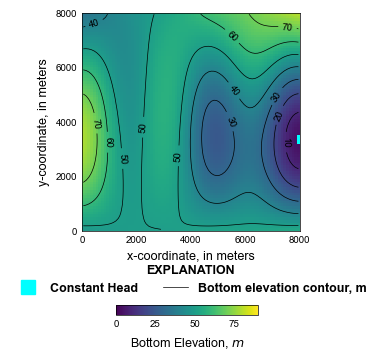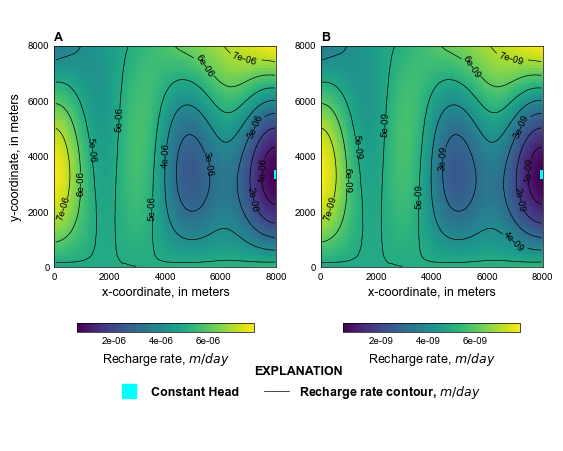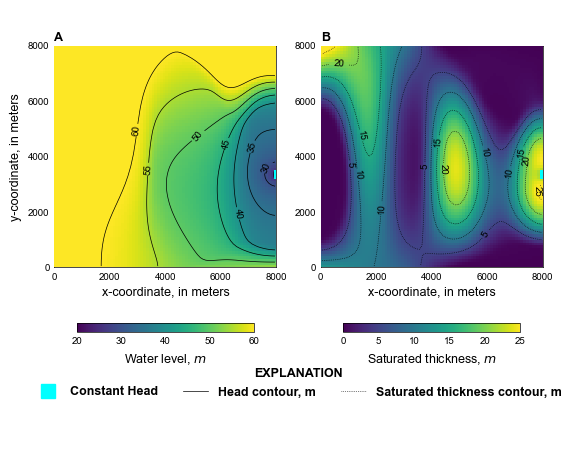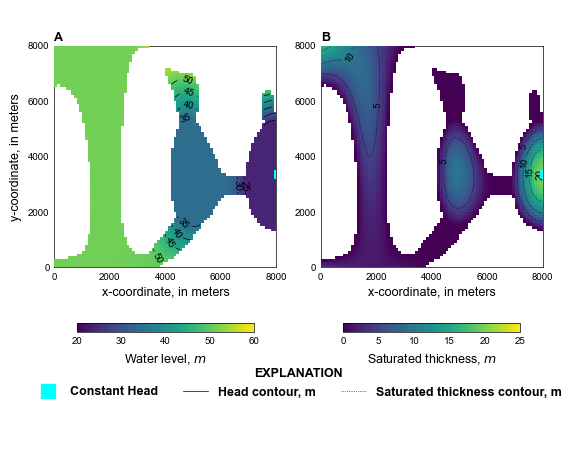MODFLOW-NWT Problem 3 example
This example is based on problem 3 in Niswonder et al 2011, which used the Newton-Raphson formulation to simulate water levels in a rectangular, unconfined aquifer with a complex bottom elevation and receiving areally distributed recharge. This problem provides a good example of the utility of Newton-Raphson for solving problems with wetting and drying of cells.
Initial setup
Import dependencies, define the example name and workspace, and read settings from environment variables.
[1]:
import os
import pathlib as pl
import flopy
import git
import matplotlib as mpl
import matplotlib.pyplot as plt
import numpy as np
import pooch
from flopy.plot.styles import styles
from modflow_devtools.misc import get_env, timed
# Example name and workspace paths. If this example is running
# in the git repository, use the folder structure described in
# the README. Otherwise just use the current working directory.
sim_name = "ex-gwf-nwt-p03"
try:
root = pl.Path(git.Repo(".", search_parent_directories=True).working_dir)
except:
root = None
workspace = root / "examples" if root else pl.Path.cwd()
figs_path = root / "figures" if root else pl.Path.cwd()
data_path = root / "data" / sim_name if root else pl.Path.cwd()
# Settings from environment variables
write = get_env("WRITE", True)
run = get_env("RUN", True)
plot = get_env("PLOT", True)
plot_show = get_env("PLOT_SHOW", True)
plot_save = get_env("PLOT_SAVE", True)
Define parameters
Define model units, parameters and other settings.
[2]:
# Model units
length_units = "meters"
time_units = "days"
# Scenario-specific parameters
parameters = {
"ex-gwf-nwt-p03a": {
"recharge": "high",
},
"ex-gwf-nwt-p03b": {
"recharge": "low",
},
}
# Model parameters
nper = 1 # Number of periods
nlay = 1 # Number of layers
nrow = 80 # Number of rows
ncol = 80 # Number of columns
delr = 100.0 # Cell size in the x-direction ($m$)
delc = 100.0 # Cell size in y-direction ($m$)
top = 200.0 # Top of the model ($m$)
k11 = 1.0 # Horizontal hydraulic conductivity ($m/day$)
H1 = 24.0 # Constant head water level ($m$)
# plotting ranges and contour levels
vmin, vmax = 20, 60
smin, smax = 0, 25
bmin, bmax = 0, 90
vlevels = np.arange(vmin, vmax + 5, 5)
slevels = np.arange(smin, smax + 5, 5)
blevels = np.arange(bmin + 10, bmax, 10)
vcolor = "black"
scolor = "black"
bcolor = "black"
# Time discretization
tdis_ds = ((365.0, 1, 1.0),)
# Calculate extents, and shape3d
extents = (0, delr * ncol, 0, delc * nrow)
shape3d = (nlay, nrow, ncol)
ticklabels = np.arange(0, 10000, 2000)
# Load the bottom
fname = "bottom.txt"
fpath = pooch.retrieve(
url=f"https://github.com/MODFLOW-USGS/modflow6-examples/raw/master/data/{sim_name}/{fname}",
fname=fname,
path=data_path,
known_hash="md5:0fd4b16db652808c7e36a5a2a25da0a2",
)
botm = np.loadtxt(fpath).reshape(shape3d)
# Set the starting heads
strt = botm + 20.0
# Load the high recharge rate
fname = "recharge_high.txt"
fpath = pooch.retrieve(
url=f"https://github.com/MODFLOW-USGS/modflow6-examples/raw/master/data/{sim_name}/{fname}",
fname=fname,
path=data_path,
known_hash="md5:8d8f8bb3cec22e7a0cbe6aba95da8f35",
)
rch_high = np.loadtxt(fpath)
# Generate the low recharge rate from the high recharge rate
rch_low = rch_high.copy() * 1e-3
# Constant head boundary conditions
chd_spd = [
[0, i, ncol - 1, H1]
for i in (
45,
46,
47,
)
]
# Solver parameters
nouter = 500
ninner = 500
hclose = 1e-9
rclose = 1e-6
Model setup
Define functions to build models, write input files, and run the simulation.
[3]:
def build_models(
name,
recharge="high",
):
sim_ws = os.path.join(workspace, name)
sim = flopy.mf6.MFSimulation(sim_name=sim_name, sim_ws=sim_ws, exe_name="mf6")
flopy.mf6.ModflowTdis(sim, nper=nper, perioddata=tdis_ds, time_units=time_units)
flopy.mf6.ModflowIms(
sim,
print_option="all",
complexity="simple",
linear_acceleration="bicgstab",
outer_maximum=nouter,
outer_dvclose=hclose,
inner_maximum=ninner,
inner_dvclose=hclose,
rcloserecord=rclose,
)
gwf = flopy.mf6.ModflowGwf(
sim,
modelname=sim_name,
newtonoptions="newton under_relaxation",
)
flopy.mf6.ModflowGwfdis(
gwf,
length_units=length_units,
nlay=nlay,
nrow=nrow,
ncol=ncol,
delr=delr,
delc=delc,
top=top,
botm=botm,
)
flopy.mf6.ModflowGwfnpf(
gwf,
icelltype=1,
k=k11,
)
flopy.mf6.ModflowGwfic(gwf, strt=strt)
flopy.mf6.ModflowGwfchd(gwf, stress_period_data=chd_spd)
if recharge == "high":
rch = rch_high
elif recharge == "low":
rch = rch_low
flopy.mf6.ModflowGwfrcha(gwf, recharge=rch)
head_filerecord = f"{sim_name}.hds"
flopy.mf6.ModflowGwfoc(
gwf,
head_filerecord=head_filerecord,
saverecord=[("HEAD", "ALL")],
)
return sim
def write_models(sim, silent=True):
sim.write_simulation(silent=silent)
@timed
def run_models(sim, silent=True):
success, buff = sim.run_simulation(silent=silent)
assert success, buff
Plotting results
Define functions to plot model results.
[4]:
# Figure properties
figure_size = (6.3, 5.6)
masked_values = (1e30, -1e30)
def create_figure(nsubs=1, size=(4, 4)):
fig = plt.figure(figsize=size, constrained_layout=False)
gs = mpl.gridspec.GridSpec(ncols=10, nrows=7, figure=fig, wspace=5)
plt.axis("off")
axes = []
if nsubs == 1:
axes.append(fig.add_subplot(gs[:5, :]))
elif nsubs == 2:
axes.append(fig.add_subplot(gs[:6, :5]))
axes.append(fig.add_subplot(gs[:6, 5:], sharey=axes[0]))
for ax in axes:
ax.set_xlim(extents[:2])
ax.set_ylim(extents[2:])
ax.set_aspect("equal")
ax.set_xticks(ticklabels)
ax.set_yticks(ticklabels)
# legend axis
axes.append(fig.add_subplot(gs[5:, :]))
# set limits for legend area
ax = axes[-1]
ax.set_xlim(0, 1)
ax.set_ylim(0, 1)
# get rid of ticks and spines for legend area
ax.axis("off")
ax.set_xticks([])
ax.set_yticks([])
ax.spines["top"].set_color("none")
ax.spines["bottom"].set_color("none")
ax.spines["left"].set_color("none")
ax.spines["right"].set_color("none")
ax.patch.set_alpha(0.0)
return fig, axes
def plot_grid(gwf, silent=True):
with styles.USGSMap() as fs:
bot = gwf.dis.botm.array
fig, axes = create_figure(size=(3.15, 4))
ax = axes[0]
mm = flopy.plot.PlotMapView(gwf, ax=ax, extent=extents)
bot_coll = mm.plot_array(bot, vmin=bmin, vmax=bmax)
mm.plot_bc("CHD", color="cyan")
cv = mm.contour_array(
bot,
levels=blevels,
linewidths=0.5,
linestyles="-",
colors=bcolor,
)
plt.clabel(cv, fmt="%1.0f")
ax.set_xlabel("x-coordinate, in meters")
ax.set_ylabel("y-coordinate, in meters")
styles.remove_edge_ticks(ax)
# legend
ax = axes[1]
ax.plot(
-10000,
-10000,
lw=0,
marker="s",
ms=10,
mfc="cyan",
mec="cyan",
label="Constant Head",
)
ax.plot(
-10000,
-10000,
lw=0.5,
ls="-",
color=bcolor,
label="Bottom elevation contour, m",
)
styles.graph_legend(ax, loc="center", ncol=2)
cax = plt.axes([0.275, 0.125, 0.45, 0.025])
cbar = plt.colorbar(
bot_coll,
shrink=0.8,
orientation="horizontal",
cax=cax,
)
cbar.ax.tick_params(size=0)
cbar.ax.set_xlabel(r"Bottom Elevation, $m$")
if plot_show:
plt.show()
if plot_save:
fpth = figs_path / f"{sim_name}-grid.png"
fig.savefig(fpth)
def plot_recharge(gwf, silent=True):
with styles.USGSMap():
fig, axes = create_figure(nsubs=2, size=figure_size)
ax = axes[0]
mm = flopy.plot.PlotMapView(gwf, ax=ax, extent=extents)
rch_coll = mm.plot_array(rch_high)
mm.plot_bc("CHD", color="cyan")
cv = mm.contour_array(
rch_high,
levels=[1e-6, 2e-6, 3e-6, 4e-6, 5e-6, 6e-6, 7e-6],
linewidths=0.5,
linestyles="-",
colors="black",
)
plt.clabel(cv, fmt="%1.0e")
cbar = plt.colorbar(
rch_coll,
shrink=0.8,
orientation="horizontal",
ax=ax,
format="%.0e",
)
cbar.ax.tick_params(size=0)
cbar.ax.set_xlabel(r"Recharge rate, $m/day$")
ax.set_xlabel("x-coordinate, in meters")
ax.set_ylabel("y-coordinate, in meters")
styles.heading(ax, letter="A")
styles.remove_edge_ticks(ax)
ax = axes[1]
mm = flopy.plot.PlotMapView(gwf, ax=ax, extent=extents)
rch_coll = mm.plot_array(rch_low)
mm.plot_bc("CHD", color="cyan")
cv = mm.contour_array(
rch_low,
levels=[1e-9, 2e-9, 3e-9, 4e-9, 5e-9, 6e-9, 7e-9],
linewidths=0.5,
linestyles="-",
colors="black",
)
plt.clabel(cv, fmt="%1.0e")
cbar = plt.colorbar(
rch_coll,
shrink=0.8,
orientation="horizontal",
ax=ax,
format="%.0e",
)
cbar.ax.tick_params(size=0)
cbar.ax.set_xlabel(r"Recharge rate, $m/day$")
ax.set_xlabel("x-coordinate, in meters")
styles.heading(ax, letter="B")
styles.remove_edge_ticks(ax)
# legend
ax = axes[-1]
ax.plot(
-10000,
-10000,
lw=0,
marker="s",
ms=10,
mfc="cyan",
mec="cyan",
label="Constant Head",
)
ax.plot(
-10000,
-10000,
lw=0.5,
ls="-",
color=bcolor,
label=r"Recharge rate contour, $m/day$",
)
styles.graph_legend(ax, loc="center", ncol=2)
if plot_show:
plt.show()
if plot_save:
fpth = figs_path / f"{sim_name}-01.png"
fig.savefig(fpth)
def plot_results(idx, sim, silent=True):
with styles.USGSMap():
gwf = sim.get_model(sim_name)
bot = gwf.dis.botm.array
if idx == 0:
plot_grid(gwf, silent=silent)
plot_recharge(gwf, silent=silent)
# create MODFLOW 6 head object
hobj = gwf.output.head()
# get times
times = hobj.get_times()
# extract heads and specific discharge
head = hobj.get_data(totim=times[0])
imask = head <= bot + 0.001
head[imask] = -1e30
sat_thick = head - botm
sat_thick[imask] = -1e30
# Create figure for simulation
fig, axes = create_figure(nsubs=2, size=figure_size)
ax = axes[0]
mm = flopy.plot.PlotMapView(gwf, ax=ax, extent=extents)
h_coll = mm.plot_array(
head, vmin=vmin, vmax=vmax, masked_values=masked_values, zorder=10
)
cv = mm.contour_array(
head,
masked_values=masked_values,
levels=vlevels,
linewidths=0.5,
linestyles="-",
colors=vcolor,
zorder=10,
)
plt.clabel(cv, fmt="%1.0f", zorder=10)
mm.plot_bc("CHD", color="cyan", zorder=11)
cbar = plt.colorbar(
h_coll,
shrink=0.8,
orientation="horizontal",
ax=ax,
format="%.0f",
)
cbar.ax.tick_params(size=0)
cbar.ax.set_xlabel(r"Water level, $m$")
ax.set_xlabel("x-coordinate, in meters")
ax.set_ylabel("y-coordinate, in meters")
styles.heading(ax, letter="A")
styles.remove_edge_ticks(ax)
ax = axes[1]
mm = flopy.plot.PlotMapView(gwf, ax=ax, extent=extents)
s_coll = mm.plot_array(
sat_thick,
vmin=smin,
vmax=smax,
masked_values=masked_values,
zorder=10,
)
cv = mm.contour_array(
sat_thick,
masked_values=masked_values,
levels=slevels,
linewidths=0.5,
linestyles=":",
colors=scolor,
zorder=10,
)
plt.clabel(cv, fmt="%1.0f", zorder=10)
mm.plot_bc("CHD", color="cyan", zorder=11)
cbar = plt.colorbar(
s_coll,
shrink=0.8,
orientation="horizontal",
ax=ax,
format="%.0f",
)
cbar.ax.tick_params(size=0)
cbar.ax.set_xlabel(r"Saturated thickness, $m$")
ax.set_xlabel("x-coordinate, in meters")
# ax.set_ylabel("y-coordinate, in meters")
styles.heading(ax, letter="B")
styles.remove_edge_ticks(ax)
# create legend
ax = axes[-1]
ax.plot(
-10000,
-10000,
lw=0,
marker="s",
ms=10,
mfc="cyan",
mec="cyan",
label="Constant Head",
)
ax.plot(
-10000,
-10000,
lw=0.5,
ls="-",
color=vcolor,
label="Head contour, m",
)
ax.plot(
-10000,
-10000,
lw=0.5,
ls=":",
color=scolor,
label="Saturated thickness contour, m",
)
styles.graph_legend(ax, loc="center", ncol=3)
if plot_show:
plt.show()
if plot_save:
fpth = figs_path / f"{sim_name}-{idx + 2:02d}.png"
fig.savefig(fpth)
Running the example
Define and invoke a function to run the example scenario, then plot results.
[5]:
def scenario(idx, silent=True):
key = list(parameters.keys())[idx]
params = parameters[key].copy()
sim = build_models(key, **params)
if write:
write_models(sim, silent=silent)
if run:
run_models(sim, silent=silent)
if plot:
plot_results(idx, sim, silent=silent)
Run the MODFLOW-NWT Problem 3 model with high recharge, then plot heads.
[6]:
scenario(0)
run_models took 244.17 ms



Run the MODFLOW-NWT Problem 3 model with low recharge, then plot heads.
[7]:
scenario(1)
run_models took 1944.94 ms
